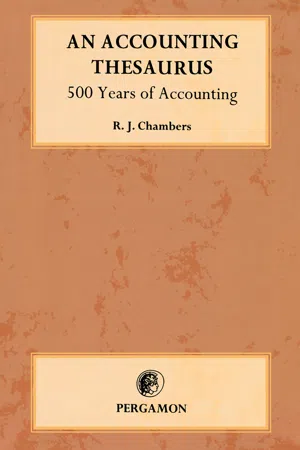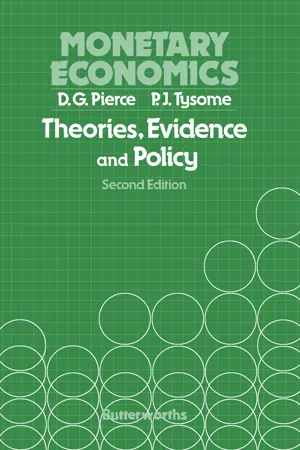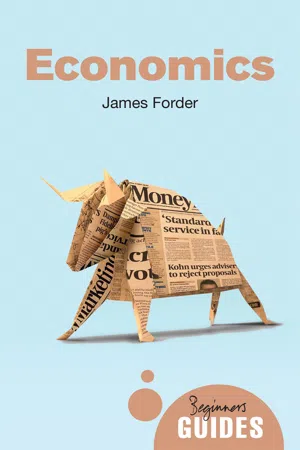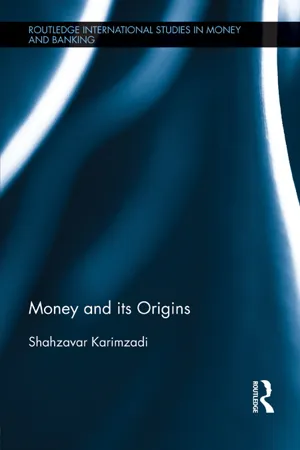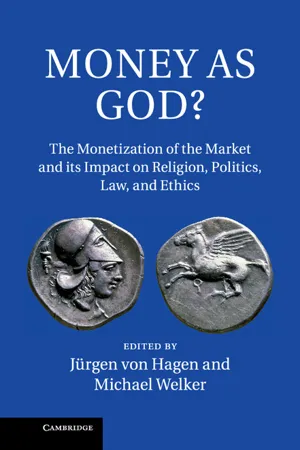Economics
Unit of Account
A unit of account is a standard unit in which prices and costs are quoted and recorded. It provides a common measure for comparing the value of different goods and services. In economics, it serves as a way to facilitate trade and economic transactions by providing a consistent means of expressing value.
Written by Perlego with AI-assistance
Related key terms
1 of 5
5 Key excerpts on "Unit of Account"
- eBook - PDF
An Accounting Thesaurus
500 years of accounting
- Richard L. Chambers(Author)
- 2014(Publication Date)
- Pergamon(Publisher)
So is the abstract side of money, the . . . Unit of Account. We reckon in pounds, use them to compute the value of miscellaneous things; we juggle mathematically with them . . . . The Unit of Account is the vehicle of our thoughts of value, price and worth. Without it we should remain pedestrian in the economic section of the mind. Coulborn, 1950/1957, 117 [The existence of money] makes possible the keeping of accounts and meaningful economic records and the making of economic estimates; thus it constitutes a Unit of Account. Croome, 1956, 8 The terms used for the unit are - besides money of account - ideal unit, Unit of Account, unit of value, and monetary unit. Some authors prefer simply to use the word money for money of account. This terminology is based on the idea that the money of account is the real and true money. Olivecrona, 1957, 77 The money unit said to be a special accounting unit The truthfulness of accounting depends largely on the truthfulness of the dollar -and the dollar is a liar! For it says one thing and means another. Sweeney, 1936/1964, xliii 102 The Economic Background of Accounting The dollar symbol which represents an asset in the accounting equation theoreti-cally remains unchanged as long as the physical asset itself remains unchanged. Where the quantity of that asset ... is actually reduced, then the financial symbol is proportionately reduced. Gilman, 1939, 248 The money symbol as used in accounting should never be read as a measure of current value. It is nothing more than a special Unit of Accounting measure-ment . . . . It is a technical measuring device. Irish, 1950, 217 The dollar sign (... before each amount in the financial statement) does not mean today's dollar. Littleton, 1970, 478 See also 253, 254 116 The dated general purchasing power of money At the same time and place, . . . money is the exact measure of the real exchange-able value of all commodities. - eBook - PDF
Monetary Economics
Theories, Evidence and Policy
- David G. Pierce, Peter J. Tysome(Authors)
- 2014(Publication Date)
- Butterworth-Heinemann(Publisher)
The use of a Unit of Account greatly reduces the number of exchange ratios between goods and services. With η commodities, one of which is acting as a Unit of Account, there will need to be only n-l rates of exchange. Without a Unit of Account, however, there will be V2n{n-) separate rates of exchange. Thus, if there are 1000 goods, one of which is a Unit of Account, then each of the remaining 999 goods will have an exchange rate in terms of the nth, i.e. there will be 999 exchange rates. With no Unit of Account, however, there will be a separate exchange rate between each pair of commodities, giving 499,500 separate exchange rates. Money as a Unit of Account is an abstract form of money, though it may have a physical counterpart. In primitive societies a tangible object such as a cow or a cowrie shell may act as the Unit of Account, so that the exchange values of all other 2 The functions, advantages and definitions of money commodities are expressed in terms of a quantity or number of cows or cowrie shells. But physical objects such as cows tend themselves to vary in the very quality they are supposed to be a measure of. In other words there is no such thing, for example, as a 'standard' cow. No two cows are exactly alike, so that if it is said that a week's labour services are equal to one cow, there is the added problem of deciding which cow is being used as the standard of measurement. Consequently, in developed monetary systems, physical units of measurement are replaced by abstract ones, which are uniform in the sense that they do not themselves vary in the quaUty measured. One pound sterhng is the same as any other pound sterHng, one USA dollar is the same as any other USA dollar etc. The Unit of Account may, as we have already suggested, have a physical counterpart. This brings us to the second meaning of the word money; money in its more 'concrete' or tangible form. - eBook - ePub
Economics
A Beginner's Guide
- James Forder(Author)
- 2016(Publication Date)
- Oneworld Publications(Publisher)
‘Unit of Account’ means the measuring rod of economic value – the units in which prices are quoted. A ‘medium of exchange’ (or ‘transactions medium’) is the device commonly used to make payments, and a ‘store of value’ is a way of taking the power to make purchases that we have today, and moving that power to purchase into the future. But those are the functions of money – they are what money does. They do not exactly tell us what money is, or how to define ‘money’. That point perhaps comes out clearly if we consider that all the functions of money might be performed by things we would not call ‘money’. The most obvious is the last of them – many things can be used as a store of value: stocks and shares, wine, land, a pile of bricks. Indeed, in principle, anything that is durable and saleable might be used to store value. Some would be better stores of value than others, of course. But that point draws attention to the fact that some of them might be better stores of value than money – in conditions of inflation, it might well make more sense to buy a house than to keep money, just to keep wealth intact. Similarly, the Unit of Account could be almost anything. It would not be impossible to list prices in terms of some commodity, whilst making payments in dollars and pounds. We could, for example, imagine the case where prices were quoted in kilos of salt. So, the price of a pint of milk might be three and a half kilos of salt, or the price of a car 30,000. In that case, salt would be the Unit of Account, even if salt was never handed over in making a payment. In a few odd cases, something like that does actually happen – the British practice of pricing racehorses in ‘guineas’, each equal to £1.05, is an example. Here, guineas are the Unit of Account, although pounds are the medium of exchange. And money as a medium of exchange is certainly not absolutely necessary. We know that from the fact that sometimes it is not used. Sometimes, we do swap goods for goods - eBook - ePub
- Shahzavar Karimzadi(Author)
- 2012(Publication Date)
- Routledge(Publisher)
The principal reason given for the Unit of Account function of money is that “it assumes the existence of customary ratios” (Coulborn 1938: 27). J. M. Keynes (1883–1946) was one of the most prominent adherents of the unit account function of money as the source of its origin. The irony is that although Keynes elevated the role of money to its highest position in contemporary economies, he failed to provide a coherent argument about its origin. He presented three different versions of the same theory. One of these three versions is the Unit of Account theory of the origin of money. His starting point for this version of the origin of money is the barter exchange. But his barter system comes with one major difference. The specific characteristic of barter exchange in this case is not the lack of a medium of exchange. In this instance there is a medium of exchange but the economic system nevertheless operates on barter exchange. Not only that, but the economy remains moneyless. For Keynes the transformation of a medium of exchange to money occurs at the point in time when debts and prices are expressed in terms of money of account. This is the precedence of the money of account in order of time to the medium of exchange that determines the source of the origin of money. In volume 1 of his Treatise on Money, this is how he describes the formation of money from its function as a Unit of Account: Money itself, namely that by delivery of which debt-contracts and price- contracts are discharged, and in the shape of which a store of General Purchasing Power is held, derives its character from its relationship to the Money-of-Account, since the debts and prices must first have been expressed in terms of the latter. Something which is merely used as a convenient medium of exchange on the spot may approach to being Money, inasmuch as it may represent a means of holding General Purchasing Power. But if this is all, we have scarcely emerged from the stage of barter - eBook - PDF
Money as God?
The Monetization of the Market and its Impact on Religion, Politics, Law, and Ethics
- Jürgen von Hagen, Michael Welker(Authors)
- 2014(Publication Date)
- Cambridge University Press(Publisher)
Accounting standards are intricate and often far from self-evident. Were it not for uniform accounting stand- ards which are agreed upon and internationally implemented (e.g. the International Financial Reporting Standards, or “IFRS”), accounting would entail many arbitrary and doubtful decisions. The need to over- come these arbitrary elements, and the never-ending struggle for “true and fair” accounting standards, show that there is no such thing as an easy “measurement” of commodities. It is simplistic to believe that commodities would readily betray their values in terms of a certain number of units of account just by being held up against the yardstick of money. Money is not itself the standard which expresses the eco- nomic value of commodities; rather, it is the unit one uses when stand- ards, such as those provided, for example, by accounting rules, are applied to commodities. If the monetary unit is comparable to a unit of measurement, like a yard, what, then, is the yardstick? It has long been taken for granted that the pricing process effortlessly attaches the “correct” monetary values to commodities. This belief has been shat- tered, as will be set out in the section below on fiat money. It is easy and, indeed, commonplace today to analytically separate the abstract monetary Unit of Account from the use of “concrete” money as a means of exchange. As to the early history of money, there is a controversy as to which function can be seen as the driving force igniting the idea of money: was money “invented” in order to facilitate contractual transactions by providing a standardized means 24 The money of account featured prominently in J. M. Keynes, A Treatise on Money, vol. I: The Pure Theory of Money. New York: Harcourt, Brace, 1930; see also Ingham, The Nature of Money, 24 ff. 25 J. Schumpeter, Das Wesen und der Hauptinhalt der theoretischen Nationalökonomie. Leipzig: Duncker & Humblot, 1908, 342 ff. 68 Wolfgang Ernst
Index pages curate the most relevant extracts from our library of academic textbooks. They’ve been created using an in-house natural language model (NLM), each adding context and meaning to key research topics.
